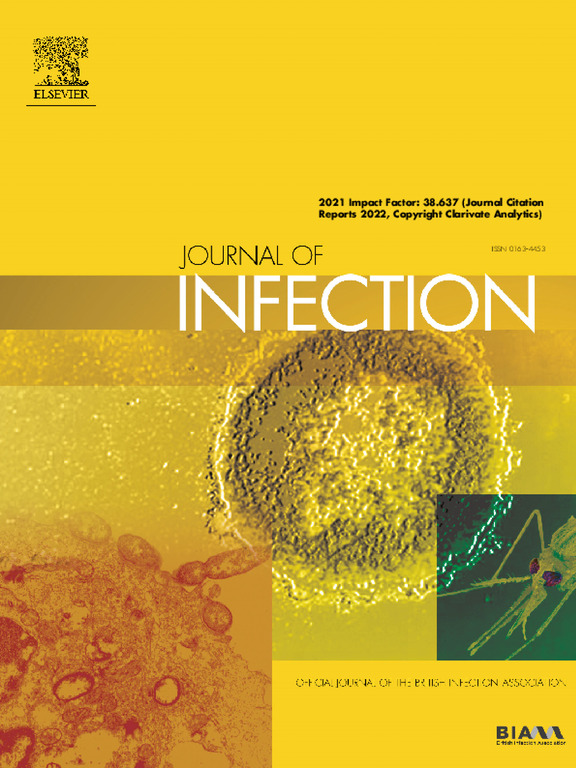由不同念珠菌种类引起的持续性念珠菌病:来自多中心当代队列的数据。
IF 11.9
1区 医学
Q1 INFECTIOUS DISEASES
引用次数: 0
摘要
方法:对意大利和西班牙3家医院的念珠菌感染患者(2018年1月- 2022年10月)进行观察性、回顾性、多中心研究。主要结局是持续性念珠菌感染,定义为血培养阳性(BC),从活性抗真菌药物开始≥5天产生相同的念珠菌。没有可用的随访bc的患者被排除在外。使用Fine和Gray回归模型进行竞争风险分析(竞争死亡风险)。结果:1188例患者中,298/1188例(25.1%)存在持续性念珠菌。与白色念珠菌相比,癌症(sHR 1.335, 95%CI 1.037-1.633, p=0.011)、总肠外营养(sHR 1.440, 95%CI 1.062-1.818, p=0.006)、假丝酵母菌病(sHR 1.312, 95%CI 0.991-1.633, p=0.03)和耳念珠菌(sHR 1.549, 95%CI 0.939-2.159, p=0.029)与持续性念珠菌感染的风险增加相关,而原发性念珠菌感染(sHR 0.573, 95%CI 0.321-0.825, p)与持续性念珠菌感染的风险增加相关。由假丝酵母菌或耳假丝酵母菌引起的感染需要个体化管理,早期源头控制对于降低持续风险至关重要。本文章由计算机程序翻译,如有差异,请以英文原文为准。
Persistent candidemia caused by different Candida species: Data from a multicenter contemporary cohort
Objectives
To explore persistent candidemia by different Candida spp.
Methods
Observational, retrospective, multicenter study including patients with candidemia (Jan 2018–Dec 2022) from 3 hospitals in Italy and Spain. The primary outcome was persistent candidemia, defined as positive blood culture (BC) yielding the same Candida spp≥5 days from the start of active antifungals. Patients with no available follow-up BCs were excluded. A competing risk analysis (competing risk of death) was performed using Fine and Gray regression models.
Results
Among 1188 patients, 298 (25.1%) had persistent candidemia. Cancer (sHR 1.335, 95% CI 1.037–1.633, p=0.011), total parenteral nutrition (sHR 1.440, 95%CI 1.062–1.818, p=0.006), Candida parapsilosis (sHR 1.312, 95% CI 1.075–1.633, p=0.03) and Candida auris (sHR 1.549, 95% CI 1.155–2.159, p=0.029) compared to Candida albicans, were associated with increased risk of persistent candidemia, whereas primary candidemia (sHR 0.573, 95% CI 0.321–0.825, p<0.001) and early source control (sHR 0.557, 95% CI 0.401–0.713, p<0.001) were protective. Persistent candidemia was associated with higher 30-day mortality (aHR 1.605, 95% CI 1.176–2.191, p=0.003).
Conclusions
Persistent candidemia affects one in four patients with Candida BSI. Infections caused by Candida parapsilosis or Candida auris require individualized management, with early source control being essential to reduce the risk of persistence.
求助全文
通过发布文献求助,成功后即可免费获取论文全文。
去求助
来源期刊

Journal of Infection
医学-传染病学
CiteScore
45.90
自引率
3.20%
发文量
475
审稿时长
16 days
期刊介绍:
The Journal of Infection publishes original papers on all aspects of infection - clinical, microbiological and epidemiological. The Journal seeks to bring together knowledge from all specialties involved in infection research and clinical practice, and present the best work in the ever-changing field of infection.
Each issue brings you Editorials that describe current or controversial topics of interest, high quality Reviews to keep you in touch with the latest developments in specific fields of interest, an Epidemiology section reporting studies in the hospital and the general community, and a lively correspondence section.
 求助内容:
求助内容: 应助结果提醒方式:
应助结果提醒方式:


